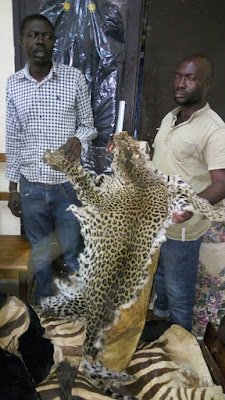Two arrested with illegal Zebra skins
Two people were arrested on 27 January 2017
by wildlife officials of the Centre Regional Delegation of Forestry and
Wildlife for trafficking in 3 zebra skins, a leopard skin and several pieces of
carved ivory. The two were arrested during an operation carried out in
collaboration with police officers from
the 10th police station in Yaounde after the suspects had ferried the products
inside a black car to the
Nlongkakneighbourhood in Yaounde. As they pulled clear and stopped shortly
before transactions could presumably begin, they were approached and questioned
by a team that thoroughly searched the car and found two suspiciously bulging
bags inside the boot of the car. The Last Great Ape Organisation (LAGA)
provided technical assistance during the operation.
According
to sources close to the investigations, the zebra skins came all the way from
Tanzania and the operation is assumed to be the first ever arrest operation
involving the zebra in the country. They say the suspects, aged 42 and 32,
worked as a team of at least three. The third member of the gang who is the
supplier, furnishing wildlife products, is still at large. One of the
traffickers sells several art objects in front of a popular bank opposite the
CNPS head office in Yaounde. The second trafficker is said to be a sculptor who
carves ivory among other products.
Cameroon
is not a zebra range state and has no populations of zebras existing in the wild and observers say the arrest demonstrates the
extent of the illegal trade in skins which spans thousands of miles and across
several countries. This is done by a professional network of buyers, smugglers
and sellers who all collude for common purpose and aim, to make as much money
from the illegal trade as possible but who also have little concern about the
threats posed to wildlife species on the continent today.
The
two are presently behind bars while the prosecution process is underway.
According to the wildlife law, anyone found in possession of a protected
wildlife species is considered to have captured or skill the animal and is
therefore liable to a prison term of up to 3 years and or payment of a fine of
up to 10 million CFA francs. The two risk these penalties even for the
trafficking in zebra skins although there are no zebras in the country. The law
nevertheless classifies zebras, so it is illegal to trade in the species in the
country.
Zebra
skins and hides are mainly used in the fashion industry for luxury handbags and
shoes but they are also used for decorative purposes inside sitting rooms. It
had been claimed by some observers that the trafficking in the country is
mainly for decorative purposes while some skins are simply transiting to other
countries in West Africa.
Among
the three species of zebras, the plains zebra is the most common and it is
found mostly in Southern and Eastern Africa, ranging from South Sudan to as far
as southern Angola and northern South Africa while the Grevy’s zebra is the
rarest of the three species; found in
Ethiopia and Kenya. The mountain zebra populates Southwest Africa, found in
countries including Angola and Namibia.
Pic
Zebra skins


No comments:
Post a Comment